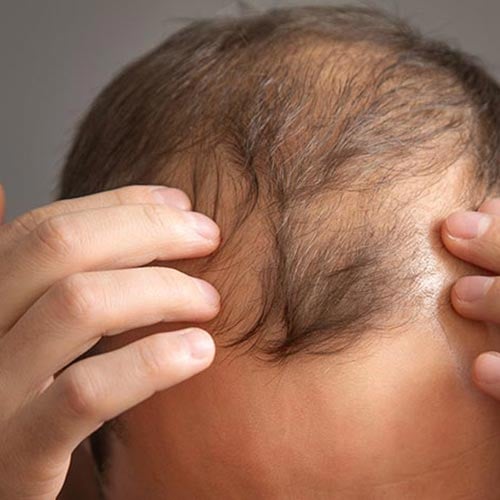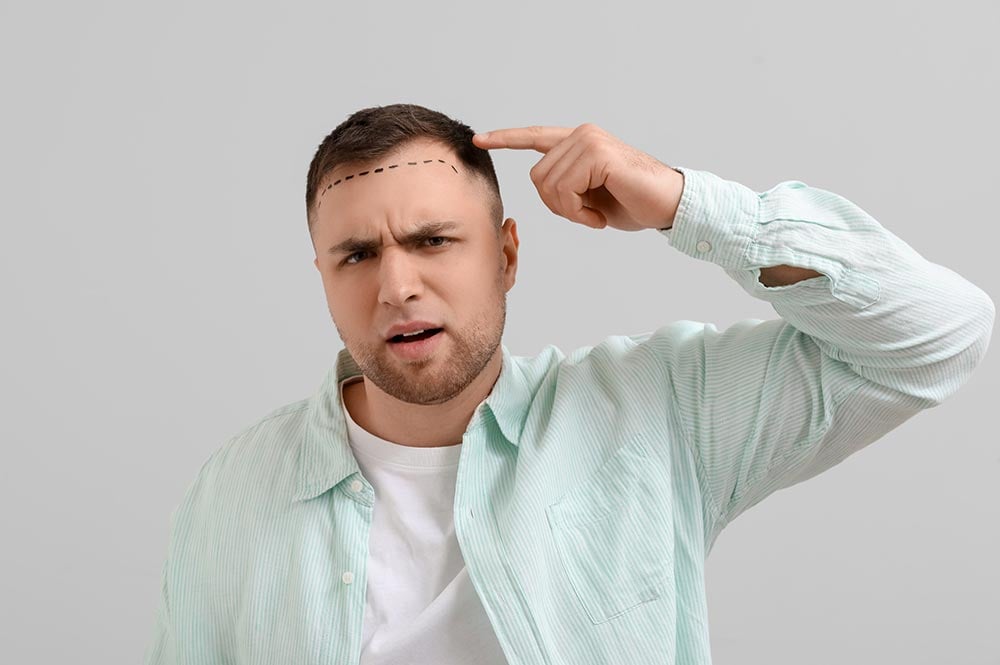What is Robotic Hair Transplantation?
Robotic hair transplantation is an innovative hair restoration technique in which hair follicles are harvested and implanted automatically using advanced technology. Compared to manual techniques, this method offers a more precise and accurate procedure. The application of robotic hair transplantation involves a detailed scalp analysis, selection of healthy grafts, and placement to achieve a natural-looking hairline. Robotic systems extract hair follicles without damaging the skin tissue and perform the implantation process with high precision. This technology stands out by enhancing the success rate of aesthetic results, minimizing tissue damage, and ensuring a faster recovery period.


İÇİNDEKİLER
How is Robotic Hair Transplantation Performed?
Robotic hair transplantation is carried out using advanced technology designed to implant hair follicles at a precise density and angle. The procedure begins with an analysis of hair loss, followed by robotic devices selecting and harvesting healthy hair follicles from the donor area. These follicles are then implanted in alignment with the natural hair growth pattern. The robotic hair transplant technique enhances accuracy while minimizing errors associated with manual procedures. Additionally, it takes less time than traditional methods and reduces the risk of follicle damage.

Working Principle of Robotic Hair Transplant Devices
Robotic hair transplant devices analyze the scalp using high-resolution imaging systems and algorithms. The system carefully selects and extracts healthy hair follicles from the donor area with precision, preventing errors commonly caused by manual methods. The key advantage of robotic hair transplantation lies in its technological precision and accuracy, making the procedure more reliable.
Graft Harvesting Process with Robotic Systems
The graft harvesting process involves robotic devices analyzing and selecting hair follicles before extracting them without causing damage. This ensures that the follicles are collected while preserving the integrity of the surrounding skin tissue, leading to a faster recovery. The robotic hair transplant technique optimizes graft utilization and enhances the overall success of the procedure.
Impact of the Robotic Method on Operation Time
Robotic hair transplantation significantly reduces the procedure duration compared to manual methods. The robotic system quickly and accurately extracts hair follicles, shortening the overall treatment time. This improves both patient and surgeon comfort while enhancing the quality of the final results. The advantages of robotic hair transplantation stand out due to its speed and improved aesthetic outcomes.
How Does Robotic Hair Transplantation Differ from Other Methods?
Robotic hair transplantation offers greater precision and more natural results compared to manual techniques. By utilizing advanced technology, this procedure minimizes errors and ensures that hair follicles are implanted at the correct angles. The key difference of robotic hair transplantation lies in reducing human intervention, thereby enhancing the success of aesthetic outcomes. Additionally, robotic technology allows for precise hair density and a naturally designed hairline.
Comparison of Robotic Hair Transplantation and the FUE Method
While the FUE method is performed manually, robotic hair transplantation relies on technology for accuracy. Robotic devices analyze, select, and extract hair follicles with precision, improving the overall success of the procedure. The advantage of robotic hair transplantation is its ability to harvest and implant grafts without damage, leading to long-lasting results.
The Role of Robotic Technology in Achieving a Natural Look
Robotic hair transplantation ensures a natural appearance by implanting follicles in alignment with the natural hair growth pattern. This technology allows for a customized hairline design, delivering aesthetically satisfying results. The key advantage of robotic hair transplantation is its ability to enhance natural-looking outcomes, distinguishing it from other methods.
Consult Now!
Fill out the form to get detailed information about the hair
transplant process and personalized solutions tailored for you!
Precision Differences Between Manual and Robotic Techniques
Manual methods are more prone to human error, whereas robotic hair transplantation extracts and implants follicles with millimetric precision. This results in a more symmetrical and natural outcome. In terms of accuracy and precision, robotic hair transplantation surpasses manual techniques, offering superior results.
What Are the Advantages of Robotic Hair Transplantation?
Robotic hair transplantation minimizes the risk of error during the procedure, providing a more comfortable experience for both the patient and the doctor. Thanks to advanced technology, hair follicles are harvested without damage and implanted at precise angles. This method stands out for causing minimal tissue trauma and ensuring a faster healing process. The advantages of robotic hair transplantation include natural-looking results and long-term patient satisfaction.
Reduced Tissue Damage with Robotic Technology
Robotic hair transplantation extracts hair follicles without harming the surrounding tissues. This accelerates the healing process and reduces the risk of infection. One of the key benefits of robotic hair transplantation is its ability to minimize tissue damage, making recovery smoother for patients.
Speed and Precision Benefits of Robotic Systems
Robotic systems quickly and accurately harvest hair follicles, shortening the overall procedure time. Additionally, they ensure that follicles are implanted at the correct angle and density, enhancing aesthetic results. The robotic hair transplantation technique stands out for its speed and precision compared to manual methods.
Long-Term Results of Robotic Hair Transplantation
By ensuring the proper placement of hair follicles, robotic hair transplantation delivers long-lasting and permanent results. The procedure provides a natural and aesthetically pleasing appearance after transplantation. One of the major advantages of robotic hair transplantation is the ability to achieve satisfying results that last for many years.
Is Robotic Hair Transplantation Suitable for Everyone?
Robotic hair transplantation is an ideal method for many individuals, but it may not be suitable for everyone. The success of this technique depends on factors such as the type of hair loss, the density of the donor area, and overall health status. Since robotic hair transplantation is performed with high technological precision, it offers a high success rate for suitable candidates. However, a detailed pre-procedure evaluation is essential to determine whether a person is a good candidate for the treatment.
Determining Suitable Candidates for Robotic Hair Transplantation
Ideal candidates for robotic hair transplantation typically have sufficient hair density in the donor area and a stabilized pattern of hair loss. Additionally, their overall health condition should be assessed. The robotic hair transplantation process provides natural and long-lasting results for such individuals. A thorough medical evaluation by a specialist enhances the success of the treatment.
Effectiveness of the Robotic Method Based on Hair Loss Type
The type of hair loss directly impacts the effectiveness of robotic hair transplantation. This method is particularly successful in cases of androgenetic alopecia, a common form of genetic hair loss. The key difference of robotic hair transplantation is its ability to create a personalized treatment plan based on the specific hair loss pattern.
The Relationship Between Robotic Hair Transplantation, Age, and Health Conditions
Robotic hair transplantation is generally suitable for individuals between the ages of 25 and 65. However, overall health is also a crucial factor. Individuals with conditions such as diabetes, hypertension, or skin disorders require a specialized assessment before undergoing the procedure. The advantages of robotic hair transplantation are more pronounced in candidates who meet the necessary health criteria.
How Does the Recovery Process Work After Robotic Hair Transplantation?
The recovery process after robotic hair transplantation is generally faster and more comfortable compared to other methods. The precision provided by advanced technology minimizes tissue damage to the scalp, accelerating the healing process. The first few weeks are crucial for the newly transplanted hair follicles to settle properly. By following proper aftercare and medical recommendations, the success of robotic hair transplantation recovery can be maximized.
Faster Recovery with the Robotic Method
Since robotic hair transplantation minimizes tissue trauma, the healing process is significantly faster. The extracted hair follicles are implanted without causing damage to surrounding tissues, reducing the risk of infection and improving graft survival. The advantages of robotic hair transplantation become evident during the recovery phase.
Precautions for the First Week After Hair Transplantation
The first week is a critical period for the newly transplanted hair follicles to adapt. During this time, protecting the scalp from impacts, maintaining hygiene, and avoiding direct sunlight are essential. The healing process after robotic hair transplantation progresses more smoothly when patients strictly adhere to medical advice.
The Role of Robotic Technology in Recovery
The precision of robotic technology makes the recovery process more comfortable. Minimal tissue damage lowers the risk of infection and supports faster hair growth. The application of robotic hair transplantation distinguishes itself from other methods through these technological advantages.
Comparison of Robotic Hair Transplantation with Other Techniques
Robotic hair transplantation offers greater precision and superior aesthetic results compared to manual methods. With the support of technology, this procedure ensures the accurate placement of hair follicles, creating a more natural appearance. The key difference of robotic hair transplantation lies in its ability to minimize errors, ensuring long-term success.
Cost and Performance Evaluation of Robotic Hair Transplantation
While robotic hair transplantation may have a higher cost compared to other techniques, its precision and long-lasting results justify the investment. The advantages of robotic hair transplantation make it a worthwhile option for those seeking permanent and high-quality outcomes.
Success Rates of Robotic vs. Manual Methods
Manual hair transplant techniques are prone to a higher margin of error, which can lead to undesirable aesthetic results. Robotic systems enhance the accuracy of follicle placement by optimizing angle and density, leading to improved success rates. The difference of robotic hair transplantation is evident in its ability to achieve near-perfect aesthetic results.
The Role of Robotic Technology in Designing a Natural Hairline
Robotic hair transplantation offers a significant advantage in creating a natural-looking hairline. Advanced technology ensures that hair follicles are implanted in alignment with the individual’s natural hair direction and density. The application of robotic hair transplantation prioritizes natural aesthetics, meeting patient expectations effectively.
Comparison of Robotic Hair Transplantation with Other Techniques
Robotic hair transplantation offers higher precision and better aesthetic results compared to manual methods. With technological support, this procedure ensures the accurate placement of hair follicles, creating a natural-looking hairline. The key difference of robotic hair transplantation is its ability to minimize errors, ensuring long-term success.

Cost and Performance Evaluation of Robotic Hair Transplantation
Robotic hair transplantation may be more expensive than other techniques, but its precision and long-lasting results justify the investment. The advantages of robotic hair transplantation make it a worthwhile choice for those seeking permanent and high-quality outcomes.
Consult Now!
Fill out the form to get detailed information about the hair
transplant process and personalized solutions tailored for you!
Success Rates of Robotic vs. Manual Methods
Manual hair transplant methods carry a higher risk of error, which can lead to undesirable aesthetic results. Robotic systems improve the accuracy of follicle placement by optimizing angles and density, leading to higher success rates. The difference of robotic hair transplantation is evident in its ability to achieve near-perfect aesthetic outcomes.
The Role of Robotic Technology in Designing a Natural Hairline
Robotic hair transplantation has a significant advantage in creating a natural-looking hairline. Advanced technology ensures that hair follicles are implanted in alignment with the individual’s natural hair direction and density. The application of robotic hair transplantation prioritizes natural aesthetics, effectively meeting patient expectations.

